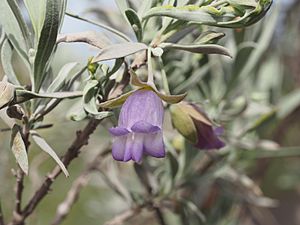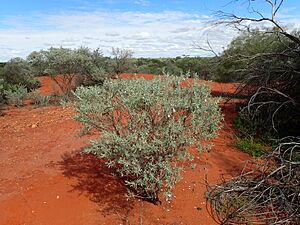Shark Bay poverty bush facts for kids
Quick facts for kids Shark Bay poverty bush |
|
|---|---|
 |
|
| E. maitlandii leaves and flowers | |
| Scientific classification | |
| Genus: |
Eremophila (plant)
|
| Species: |
maitlandii
|
| Synonyms | |
|
|
The Eremophila maitlandii, often called the Shark Bay poverty bush, is a lovely flowering plant. It belongs to the figwort family, called Scrophulariaceae. This plant is special because it is only found in Western Australia. It looks like a silvery-grey bush with long, thin leaves. Its flowers are a pretty lilac or light purple color. You can often find it near the coast between Shark Bay and Carnarvon.
Contents
What Does It Look Like?
The Shark Bay poverty bush grows as an upright bush or a small tree. It can reach a height of about 1 to 4 meters (3 to 13 feet). Its branches and leaves are covered in soft, grey or yellowish hairs. The leaves grow in groups near the ends of the branches. They are long and narrow, like a line or an oval shape. Most leaves are about 24 to 64 millimeters (1 to 2.5 inches) long. They are also about 2.5 to 6 millimeters (0.1 to 0.2 inches) wide. Each leaf has a clear line down the middle on its underside.
The flowers grow one or two at a time where the leaves meet the stem. They sit on hairy stalks that are 13 to 22.5 millimeters (0.5 to 0.9 inches) long. There are five green, hairy, spear-shaped sepals. These sepals are 11 to 20 millimeters (0.4 to 0.8 inches) long. They get bigger after the flower blooms. The petals are 20 to 26 millimeters (0.8 to 1.0 inches) long. They join together at the bottom to form a tube. The outside of this tube is lilac or purple. Inside, it's lighter with faint lilac spots. The petals and their parts are mostly smooth, meaning they have no hairs. But the inside of the tube is full of long, soft hairs. The four stamens, which are part of the flower, are completely hidden inside the petal tube.
This plant flowers from May to December. After flowering, it produces cone-shaped fruits with a pointed end. These fruits are smooth and about 7.5 to 9.5 millimeters (0.3 to 0.4 inches) long.

Where Did Its Name Come From?
The Shark Bay poverty bush was first officially described in 1870. A botanist named George Bentham gave it its formal description. He wrote about it in a book called Flora Australiensis. The second part of its scientific name, maitlandii, honors a person named Maitland Brown.
Where Does It Live?
The Shark Bay poverty bush is very common between Shark Bay and Carnarvon. It often grows on sandy dunes near the coast. However, it can also be found further inland. You might see it as far as the Kennedy Range. It lives in several natural areas of Western Australia. These include the Carnarvon, Gascoyne, Geraldton Sandplains, Murchison, and Yalgoo regions.
Is It Endangered?
The Western Australian Government's Department of Parks and Wildlife has looked at the Shark Bay poverty bush. They have classified it as "not threatened." This means it is not currently in danger of disappearing.
Growing This Plant
People like to grow the Shark Bay poverty bush in gardens. Its tall, open shape and grey-green leaves are attractive. The pale blue to lilac flowers also make it stand out. Some people have grown this plant from cuttings in southern Queensland. Cuttings are pieces of the plant that are used to grow new ones. It has been more successful in southern Australia by grafting it onto Myoporum rootstock. Grafting means joining parts of two plants so they grow as one. The rootstock is the bottom part of the plant with roots.
This plant grows best in soil that drains water well. It also needs lots of sunshine. It can handle dry conditions quite well, so it is moderately drought resistant. However, very cold frosts can sometimes harm it.

